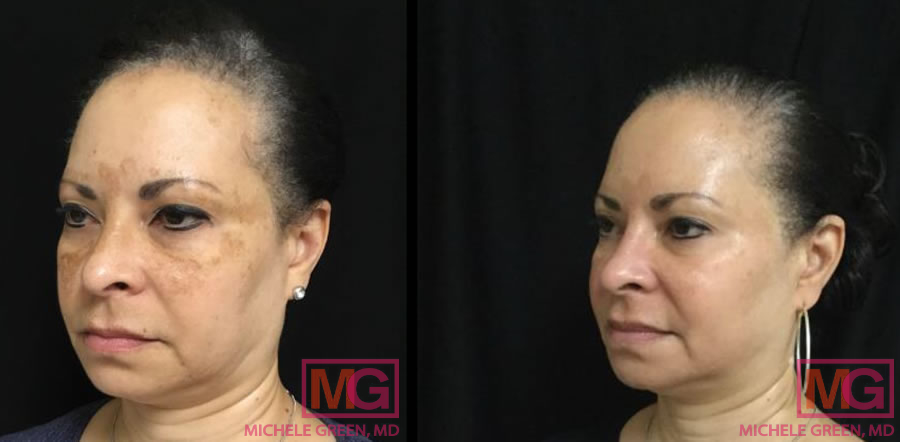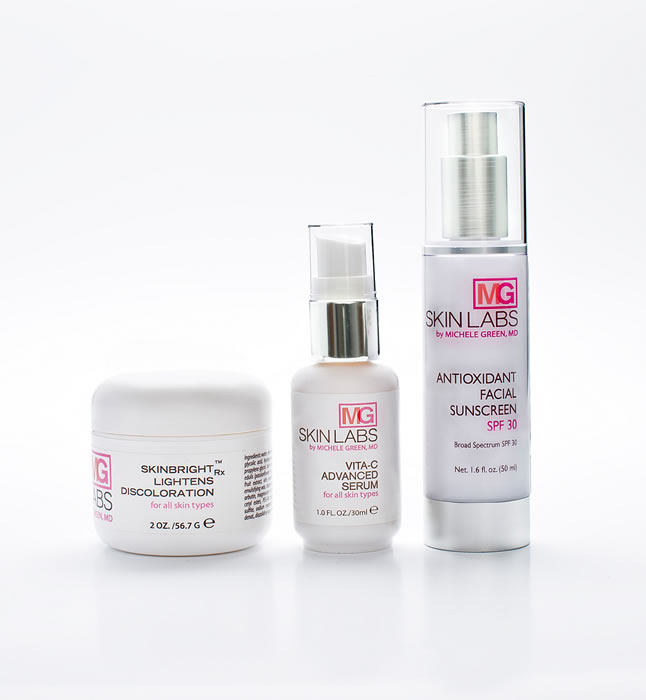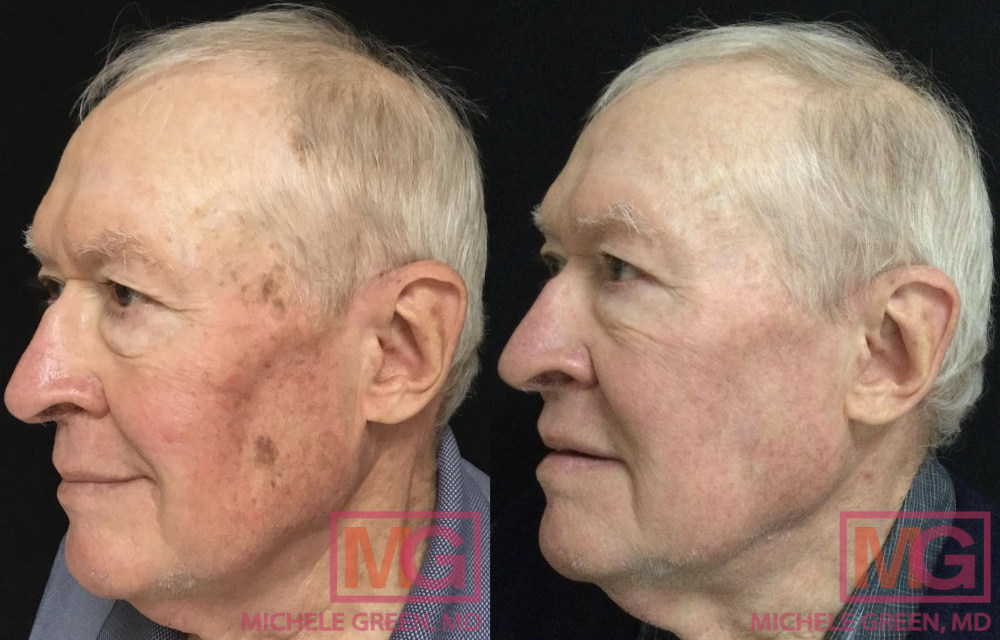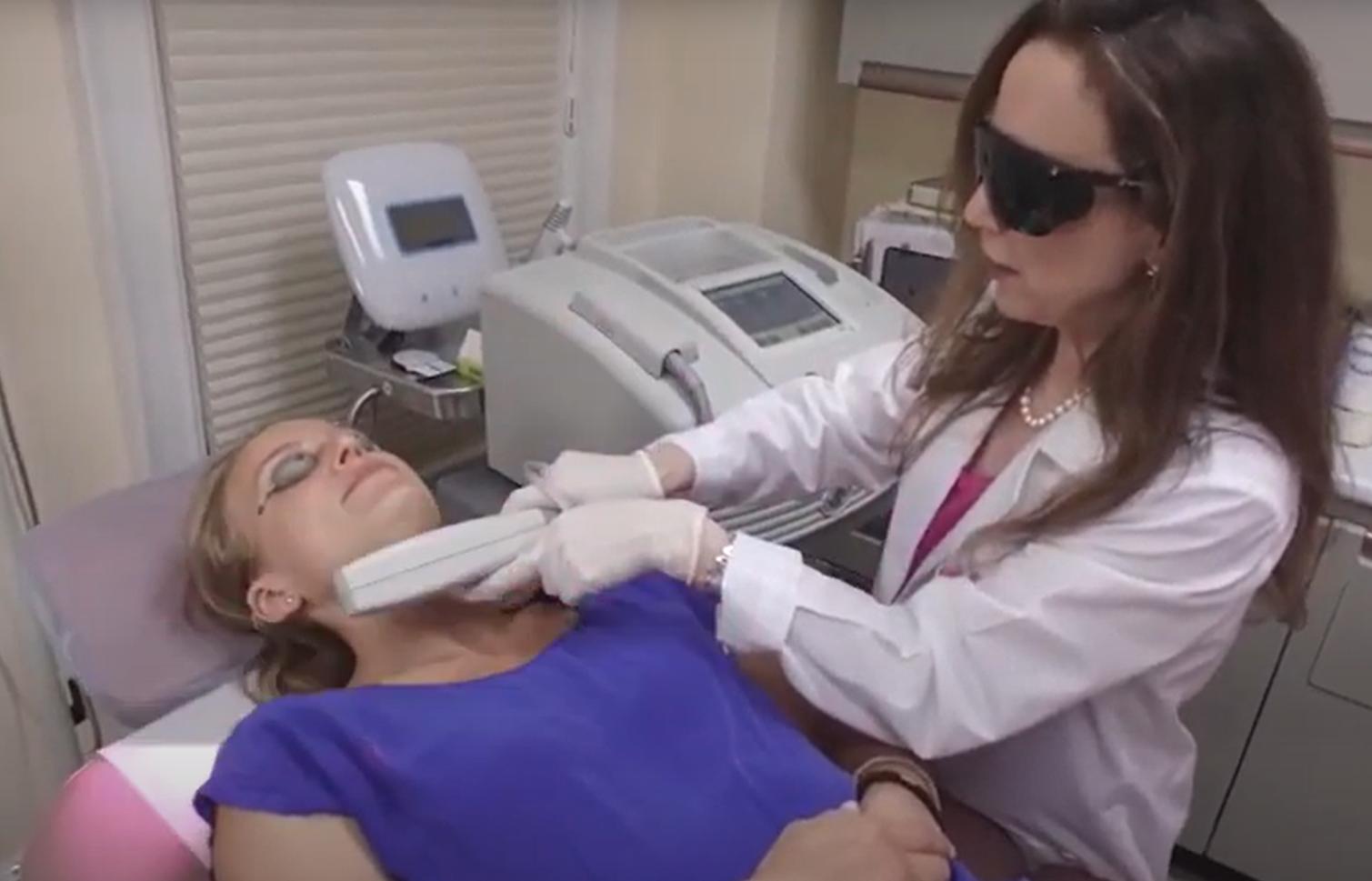Hydroquinone vs. Hydroquinone-Free Products
There are many potential reasons why patients may seek out skin-lightening creams. As we age, sun spots, age spots, melasma, and other hyperpigmentation skin conditions can develop on the skin, leading to discoloration and an overall uneven skin tone. Skin lightening creams or lotions prescribed by a board-certified dermatologist or healthcare professional can safely and effectively remove these dark spots on the skin when used as directed. However, some patients may turn to over-the-counter (OTC) creams, soaps, or powders, which are less easily regulated by the American Food and Drug Administration (FDA) and can be unsafe for use, posing potential risks to your skin and health. With many depigmentation treatment options available, it can be challenging to know what will be safest and most effective for your skin, which is why the best first step in treating dark spots is to consult with an expert, board-certified dermatologist, such as Dr. Michele Green.
One of the most common ingredients in skin-lightening products is hydroquinone, a skin-bleaching agent that limits melanin production in the skin. As a skin-lightening agent, hydroquinone can address several skin concerns, including post-inflammatory hyperpigmentation, melasma, sun damage, age spots, and freckles. While hydroquinone cream can be highly effective for many patients, misuse of the product can lead to serious side effects, including permanent skin discoloration known as exogenous ochronosis. Luckily, there are many alternatives to hydroquinone for patients looking to lighten the skin, including other topical skincare products containing tretinoin, kojic acid, vitamin C, chemical peels, and laser treatments. When you have your initial consultation with Dr. Green, she will examine the treatment area to determine the skin-lightening treatment option that will be most effective for you.
Experienced board-certified dermatologist Dr. Michele Green has been masterfully treating patients in her Upper East Side New York City dermatology office for more than 25 years. With her proprietary range of skincare products, MGSKINLABs, Dr. Green is an expert in providing patients with individualized treatment plans tailored to their skin type and aesthetic goals. Whether you are concerned about sensitive skin, hyperpigmentation, dark spots, melasma, or signs of the natural aging process, Dr. Green has plenty of treatment options. Well-known for high patient satisfaction, Dr. Green has been voted one of New York City’s best dermatologists by publications such as Castle Connolly, Super Doctors, and New York Magazine.
What is hydroquinone?
Hydroquinone is a skin-lightening agent that addresses various skin conditions, including melasma, post-inflammatory hyperpigmentation, age spots, and other discoloration. The chemical compound is commonly found in skin-bleaching creams and lotion formulations and is often highly effective at lightening and brightening the skin. In the United States, the use of hydroquinone as an ingredient is highly regulated by the FDA due to the risk of serious side effects associated with long-term exposure. According to FDA.gov, any over-the-counter products containing hydroquinone in a concentration of 2% or higher are considered unapproved and unsafe for regular use. However, prescription topical creams can contain hydroquinone in concentrations up to 5% and are safe when used as directed by a dermatologist or healthcare provider. Prescription hydroquinone cream is particularly effective for patients experiencing a flare-up of the skin condition melasma, as the condition is difficult to treat using other treatment methods.
What is hydroquinone used for in skin care?
Hydroquinone is commonly used in skin-lightening creams to reduce the appearance of dark spots and hyperpigmentation on the skin’s surface. Specifically, hydroquinone is used to address melasma, age spots, sun damage, freckles, acne scars, and uneven skin tone. Hydroquinone is especially helpful in addressing cases of melasma, a skin condition characterized by dark spots on the skin’s surface that can flare up due to sun exposure and hormonal fluctuations. The condition is notoriously difficult to treat and can respond poorly to other skin-lightening treatments like laser treatments. The hydroquinone-based topical cream Tri-Luma is often considered one of the best ways to reduce the appearance of melasma on the skin.
Tri-Luma cream is the only FDA-approved topical treatment option for treating cases of melasma. When applied to the affected areas of the skin, Tri-Luma works as a skin lightener, reducing the appearance of discoloration and inhibiting the further production of melanin in the treated area. Tri-Luma contains three active ingredients—Hydroquinone 4%, the retinoid Tretinoin 0.05%, and the corticosteroid fluocinolone acetonide 0.01%—for controlled skin bleaching, skin cell turnover, and the prevention of inflammation. These powerful active ingredients combined into one cream make Tri-Luma one of the most effective treatment options for controlling melasma. Tri-Luma is only designed for short-term use—typically prescribed for eight weeks.

How does hydroquinone work for skin lightening?
Hydroquinone works for skin lightening by reducing melanin production in the epidermis. Melanin is a pigment found throughout the body that gives the hair, skin, and eyes their color. Over-production of melanin can occur due to unprotected sun exposure, skin conditions like melasma, and the use of certain lasers on patients with darker skin tones. When the over-production of melanin occurs unevenly on the skin, patients will observe the appearance of dark patches or hyperpigmentation. Patients who want to address areas of hyperpigmentation can turn to hydroquinone-based products to lighten the skin. Hydroquinone reduces discoloration by targeting the enzyme tyrosine, essential for melanin production in the melanocytes, making hydroquinone a tyrosinase inhibitor. When the conversion of tyrosine to dihydroxyphenylalanine is disrupted, the number of melanocytes decreases, as does melanin production.
Does hydroquinone lighten the skin permanently?
Hydroquinone is highly effective at lightening the skin when prescribed by a dermatologist to address hyperpigmentation on the skin’s surface. Due to the decreased melanin production during hydroquinone treatment, the skin may be more sensitive to sunlight. Sun damage is a major risk factor for developing dark spots on the skin’s surface and can trigger a flare-up of melasma. To maintain the effects of hydroquinone treatment, patients should practice strict sun protection by wearing sunscreen with SPF 50 or higher whenever they are outside. Dr. Green recommends applying sunscreen every morning after using a gentle moisturizer as part of her patient’s regular skincare routine and reapplying every two hours outside.
What are the side effects of hydroquinone treatment?
When used as directed, patients can expect some mild, common side effects of prescription hydroquinone treatment, including contact dermatitis, which includes redness, stinging, mild burning, itching, and dryness. Some formulations of hydroquinone contain metabisulphite, a preservative that can cause allergic reactions in some patients. Be sure to inform Dr. Green during your initial consultation if you have a history of severe allergic reactions. Patients using unregulated over-the-counter hydroquinone products may experience more severe side effects, including facial swelling, exogenous ochronosis (permanent skin discoloration), and skin rashes. Hydroquinone creams are only meant for short-term use. Continuing to use hydroquinone creams for longer than prescribed can increase the risk of serious side effects.
Why is my skin darker after using hydroquinone?
One potential side effect of hydroquinone treatment is exogenous ochronosis, characterized by blue-black or gray-brown discoloration on the skin’s surface. Patients with darker skin tones are often at a higher risk of developing exogenous ochronosis, though prolonged exposure to hydroquinone products can also lead to the condition. The best way to avoid hyperpigmentation due to hydroquinone is to apply the product exactly as directed by a dermatologist. Additionally, consulting with an expert, such as Dr. Green, will help to reduce the risk of adverse side effects. Dr. Green will consider each patient’s skin type when recommending the best skin-lightening treatment.
Are hydroquinone products safe?
Hydroquinone is a common ingredient in skin-lightening creams. It inhibits melanin production in the melanocytes and helps brighten the skin. Long-term use of hydroquinone skin-lightening products and hydroquinone derivatives like Arbutin can be dangerous, as they are associated with skin irritation and permanent skin discoloration, called exogenous ochronosis, especially for patients with darker skin tones. Before applying hydroquinone to the affected area, Dr. Green will recommend testing the product on about 1cm of skin to see if any side effects like dryness, redness, and irritation arise. If not, hydroquinone is likely safe to use on the full treatment area for as long as directed.
Hydroquinone creams are not safe to use during pregnancy or breastfeeding, as the chemical compound can be absorbed into the bloodstream and affect the fetus or new baby.
What is the safest skin-lightening product?
The safest skin-lightening products are those recommended by an expert board-certified dermatologist, such as Dr. Michele Green. When treating melasma, Dr. Green will often prescribe the hydroquinone-based cream Tri-Luma, which is safe and effective when applied for a short period as directed. Dr. Green also has many in-office treatments for treating other forms of hyperpigmentation, such as sun spots, acne scars, and uneven skin tone, including chemical peels, laser treatments, and microdermabrasion. Dr. Green can also recommend non-hydroquinone-based skin-lightening creams, such as her proprietary Skinbright RX, a Kojic Acid and Fruit Extract-based cream for brightening the skin of any area of the body.
A dermatologist’s recommendation is essential because some skin-lightening products available over-the-counter (OTC) may contain higher concentrations of hydroquinone and even mercury, which can be very dangerous to patients’ long-term health. While the FDA has not approved skin-bleaching products that contain hydroquinone in the United States, it is still very easy to buy harmful products online. While many countries have restrictions on the type of ingredients used in skin-lightening products, some do not.

How to lighten the skin without hydroquinone
Topical Solutions
Tretinoin: Tretinoin is a retinoid, a vitamin A derivative, used to boost skin cell turnover and promote new skin growth. Available over the counter in low concentrations, tretinoin cream is also used to treat hyperpigmentation and reduce the appearance of wrinkles on the face and body.
Vitamin C: Vitamin C is an antioxidant that helps protect the skin from free radical damage and reduces the appearance of pigmentation and dark spots. When applied to the skin’s surface, Vitamin C can help reduce signs of aging by reducing collagen breakdown and reversing UV damage. Dr. Green has her proprietary line of skin care products, MGSKINLABs, and her Vitamin C serum is one of the most popular products sold. Topical vitamin C serums can be added to a patient’s skincare routine to lighten dark spots and protect the skin from free radicals.
Kojic Acid: Like hydroquinone, kojic acid is a tyrosinase inhibitor, which decreases pigmentation by targeting the tyrosine enzyme necessary for melanin production. As a tyrosinase inhibitor, kojic acid is found in many skin-lightening products in a concentration of less than 1%, including MGSKINLAB’s Skinbright RX for the face and body.
Chemical Peels
Chemical peels involve the application of a topical chemical solution to resurface the skin, exfoliate the treatment area, and remove the top layers of dead skin to reveal healthy, lighter skin underneath. In addition to treating hyperpigmentation, chemical peels are excellent for reducing the appearance of fine lines, skin texture, and pore size. Dr. Green employs a variety of proprietary chemical peels, which contain glycolic acid, an alpha hydroxy acid, and trichloroacetic acid, for the best results in eliminating dark spots. Chemical peels come in various strengths, and Dr. Green will determine if a light, medium, or deep chemical peel is necessary based on the severity of your sun damage. In addition to treating dark spots, chemical peels can also be used to treat melasma, a skin condition characterized by discoloration across the upper lip, cheeks, bridge of the nose, and forehead. Patients with melasma should be treated differently than patients with sunspots, as melasma cannot be treated with most lasers.

Laser Treatments
Candela Alex Trivantage Laser
The Candela Alex-Trivantage Laser is an Nd: Yag laser designed to treat discreet areas of hyperpigmentation, such as sun spots. The laser emits wavelengths of light absorbed by the pigment in dark spots on the skin. These melanin-rich lesions transform the light energy into heat, eliminating the pigmentation and stimulating the production of new, lighter, healthier skin cells. The laser specifically targets the pigmentation in the skin, meaning that the skin tissue surrounding the sunspot is unaffected by the laser treatment.
Fraxel Resurfacing Laser
Fraxel laser was the first FDA-approved fractionated laser to treat sun damage, sun spots, texture, stretch marks, precancerous growths (actinic keratoses), acne scars, fine lines, and wrinkles. The Fraxel laser works by resurfacing a “fraction” of the skin, leaving the remaining skin unaffected to minimize downtime and accelerate healing. The Fraxel laser creates “micro-injuries” on the skin, triggering skin cell turnover and new collagen production and bringing healthy, unpigmented cells to the skin’s surface. The Fraxel Dual operates on two wavelengths of light: the 1927 nm, which treats predominantly pigmentation and sun damage, and the 1550 nm, which treats fine lines, wrinkles, and acne scars. Combining the two settings can treat both conditions simultaneously, reducing sun spots and wrinkles and improving skin texture, all with only a few days of recovery.
Clear + Brilliant Laser
Clear + Brilliant laser is commonly called a “mini-Fraxel” laser. Clear + Brilliant is a gentle laser resurfacing treatment that was FDA-approved in 2011. Using fractionated laser technology, Clear + Brilliant creates millions of microscopic treatment zones in the face, stimulates new collagen production, removes dead skin cells, and produces healthy new skin. Clear + Brilliant treats sun spots, sunspots, uneven skin tone, discoloration, irregular skin texture, fine lines, and enlarged pore size. Patients of all skin tones and skin types, including darker complexions, can benefit from Clear + Brilliant laser treatment for total facial rejuvenation.
Intense Pulsed Light (IPL)
The Intense Pulsed Light (IPL) laser treatment, or photo facial, reduces signs of photoaging, facial redness, fine lines, and skin laxity to improve the overall color and texture of the skin. Intense Pulsed Light differs from laser resurfacing in that while lasers typically use a single wavelength of light, IPL lasers use several wavelengths to treat various skin conditions. The flash of light emitted from the IPL device travels to the dermal layer of the skin to destroy the melanin-rich cells in the sunspot.

Are hydroquinone-free products just as effective?
Hydroquinone-free products, including skincare creams with vitamin C, tretinoin, and kojic acid, can reduce hyperpigmentation as hydroquinone-based products. Often, hydroquinone-free products are gentler, providing patients with skin-lightening results without the risk of serious side effects. However, patients with melasma may find hydroquinone-based creams, such as Tri-Luma, the most effective treatment option for their skin condition. Melasma is notoriously difficult to control, and Tri-Luma has been FDA-approved to treat it, as it has proven safe and more effective than other methods.
What is the best alternative to hydroquinone?
Dr. Green has many available hydroquinone-free treatment options, and the “best” product to lighten the skin depends on your specific aesthetic goals, skin condition, and skin type. Regarding topical hydroquinone-free skin-lightening products, Dr. Green will frequently recommend the Skinbright RX cream, which can be used anywhere on the body, including the face, neck, and chest. While Skinbright RX is much more gentle than hydroquinone-based creams, it is still highly effective at lightening the skin. Formulated with kojic acid and fruit extract, Skinbright RX works to rejuvenate and brighten pigmented skin. Dr. Green may also recommend MGSKINLAB’s Vita C Serum, formulated with vitamin C to promote skin cell renewal and collagen production to reduce pigmentation and the appearance of fine lines and wrinkles.
Is tretinoin or hydroquinone better?
When treating skin conditions like melasma, hydroquinone and tretinoin are best combined. For example, the skin-lightening cream for the treatment of melasma, Tri-Luma, contains three active ingredients—Hydroquinone 4%, the retinoid Tretinoin 0.05%, and the corticosteroid fluocinolone acetonide 0.01%—for controlled skin bleaching, skin cell turnover, and the prevention of inflammation. Within the Tri-Luma cream, hydroquinone acts as a melanin inhibitor, reducing the production of the pigment to lighten the skin. Tretinoin is a retinoid, which is a derivative of vitamin A, that helps boost skin cell turnover. The exfoliation of discolored skin cells and the production of new, lighter skin helps reduce the appearance of dark spots on the skin’s surface. These powerful active ingredients combined into one cream make Tri-Luma one of the most effective treatment options for controlling melasma, a skin condition that is notoriously difficult to treat.
What happens to your skin when you stop using hydroquinone?
Hydroquinone cream is often highly effective at reducing discoloration on the skin’s surface. However, if patients wish to maintain the treatment results, they must address the underlying cause of the pigmentation on the skin. Dark spots on the skin can occur due to several skin conditions, including sun damage, acne scars, or melasma. While the exact cause of melasma is not known, the condition can be triggered by exposure to UV rays from the sun, sunlamps, or tanning beds and hormone fluctuations from pregnancy, puberty, or hormonal birth control pills. There is no cure for melasma, but the symptoms of the condition, including flare-ups of discoloration on the face, can be lessened and managed. To maintain the results of hydroquinone treatment, patients must address the underlying triggers for the condition. Dr. Green recommends that patients practice strict sun avoidance by wearing protective clothing and sunscreen with SPF 30 or higher. If patients are on hormonal birth control pills, Dr. Green recommends discussing other alternatives with their OB-GYN.
How to get started with skin-lightening treatment today
Skin-lightening products may be used for a variety of reasons. Dark spots, such as age spots, melasma, and hyperpigmentation, may develop on the skin’s surface as we age. With many different skin-lightening products available over the counter and online, it can be challenging to know if what you are getting is safe and effective. That is why consulting with an expert, such as experienced, board-certified dermatologist Dr. Michele Green, is always essential. Dr. Green is an expert at creating unique, individualized treatment plans for each patient, ensuring the best care for all.
Dr. Michele Green is an internationally renowned board-certified dermatologist with over two and a half decades of experience providing her patients with the best non-invasive treatment options. Dr. Green takes a holistic approach and embraces a less-is-more philosophy, creating customized skincare routines and treatment plans that cater to her patient’s unique concerns and aesthetic goals. She is consistently identified as one of New York’s best dermatologists by Castle Connolly, New York Magazine, and Super Doctors for her dedication to her patients and expertise. Please call us at 212-535-3088 or email our New York City-based office today to schedule a consultation with Dr. Michele Green and determine the right skin-lightening products for you.
 212-535-3088
212-535-3088